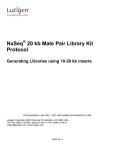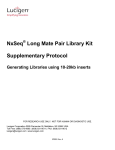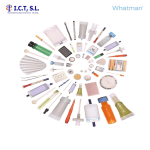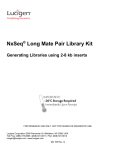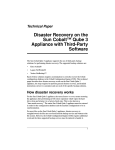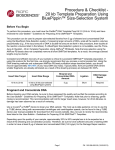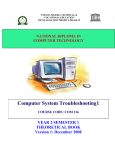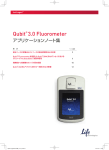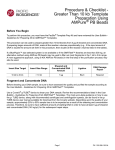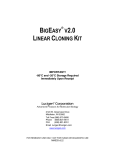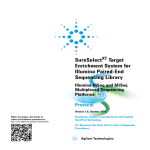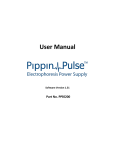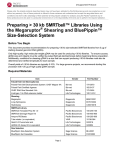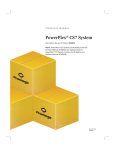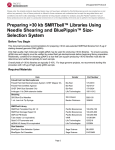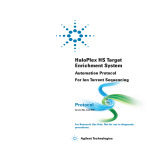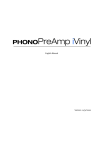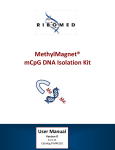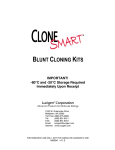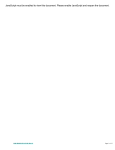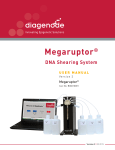Download NxSeq Long Mate Pair Library Kit
Transcript
NxSeq® Long Mate Pair Library Kit Generating Libraries using 10-20 kb inserts FOR RESEARCH USE ONLY. NOT FOR HUMAN OR DIAGNOSTIC USE. Lucigen Corporation 2905 Parmenter St, Middleton, WI 53562 USA Toll Free: (888) 575-9695 | (608) 831-9011 | FAX: (608) 831-9012 [email protected] www.lucigen.com MA162 Rev A NxSeq® 20 kb Mate Pair Library Kit Protocol Table of Contents Technical Support .............................................................................................................................. 23 Product Description ............................................................................................................................. 3 Workflow ............................................................................................................................................... 3 Product Designations........................................................................................................................... 5 Components and Storage .................................................................................................................... 5 Customer-Supplied Reagents and Equipment ................................................................................... 6 Prior to starting: Restriction Enzyme Selection ............................................................................... 89 General Recommendations ............................................................................................................... 11 Detailed Protocol ................................................................................................................................ 11 1. Shear DNA to Appropriate Size .................................................................................................. 11 2. End Repair ................................................................................................................................. 1415 3. A-Tailing..................................................................................................................................... 1516 4. Ligation of Adaptor ..................................................................................................................... 1617 5A. Size-select the Adaptor-Ligated DNA with BluePippin ............................................................. 1819 5B. Insert Size Selection using SeaKem Gold Agarose and Elutrap™ ............................................ 2223 6. Ligation of Insert to Coupler ....................................................................................................... 2627 7. Exonuclease Treatment ............................................................................................................. 2829 8. Clean Up of Exonuclease Treated Insert / Coupler ..................................................................... 2930 9. Restriction Enzyme Digest ......................................................................................................... 3031 10. Biotin Capture .......................................................................................................................... 3132 11. Junction Code Ligation ............................................................................................................. 3435 12. Clean Up of Insert / Coupler with Junction Code ...................................................................... 3637 13. DNA Re-circularization ............................................................................................................. 3839 14. Exonuclease Treatment ........................................................................................................... 3940 15. Clean Up of Exonuclease Treated Insert / Coupler .................................................................. 4041 16. Amplification Using Accura HotStart 2X Master Mix ................................................................. 4243 17. Size Selection of Amplified Mate Pair Library ........................................................................... 4849 18. Illumina Sequencing ................................................................................................................. 5152 19. Analysis of Sequencing Data from Illumina Instruments ........................................................... 5354 Appendix A. Example Experimental Set-up for Restriction Enzyme Testing ............................ 5455 Appendix B. The Effect of the Size Range of Sheared DNA on Insert Size ............................... 5556 Appendix C. Determining Bead Concentration ........................................................................... 5758 Appendix D: Additional Information on Amplification Artifacts ................................................. 5859 Appendix E: Additional Instructions for Sample Pooling Prior to Sequencing......................... 5960 Appendix F: Double Bead Clean Up Protocol.............................................................................. 6061 Appendix G. Sequence Analysis: Filtering, Scripts, Assembly Software Options ................... 6162 Appendix H: Sequence and Location Information ...................................................................... 6364 Appendix I: Size Distribution of 20kb Inserts ............................................................................. 6465 Appendix J: Removal of Contaminating Small Fragments ......................................................... 6768 Technical Support Lucigen is dedicated to the success and satisfaction of our customers. Our products are tested to assure they perform as specified when used according to our recommendations. It is imperative that the reagents supplied by the user, especially the specimens to be amplified, are of the highest quality. Please follow the instructions carefully and contact our technical service representatives if additional information is necessary. We Page 2 of 67 MA162 Rev A NxSeq® 20 kb Mate Pair Library Kit Protocol encourage you to contact us with your comments regarding the performance of our products in your applications. Thank you. Lucigen Technical Support: Email: [email protected] Phone: (888) 575-9695 Product Guarantee: Lucigen guarantees that this product will perform as specified for one year from the date of shipping. Product Description The NxSeq® Long Mate Pair Library Kit is designed to generate mate pair libraries for sequencing on Illumina platforms. When combined with fragment library sequencing data, mate pair library sequences enable superior genome assembly, closure, and finishing. Applications include de novo genome assembly, chromosomal rearrangement detection, haplotyping, and BAC sequencing. There are two protocols available for this product: This protocol (MA162) uses gel based clean up steps for insert size selection, and is recommended for spanning repeats from 10-20 kb. MA160 uses a fast and easy gel-free bead clean up step for insert size selection and is recommended for spanning repeats < 8 kb. For complex genomes, such as plant or animal genomes, we recommend constructing multiple mate pair libraries ranging from 2 - 20 kb, which would use both protocols. In most cases, very complex genomes will also benefit from a separate product, the pNGS Fosmid NxSeq 40 kb Mate Pair Library Kit (available separately). Please contact [email protected] with any questions. Workflow Using this method, genomic DNA is sheared to the desired size, end repaired, A-tailed, and ligated to adaptors. The insert is size-selected and ligated to a unique coupler that contains encrypted Chimera Code™ sequences. The circularized inserts are then treated with exonuclease to remove unwanted linear DNA and then digested with a selection of endonucleases to produce the correctly sized di-tags. Biotin capture is used to remove the unwanted DNA fragments prior to the addition of a Junction Code™ Reagent. The library is recircularized, amplified by PCR, and then sequenced on an Illumina platform. Page 3 of 67 MA162 Rev A NxSeq® 20 kb Mate Pair Library Kit Protocol Workflow Diagram: Figure 1: Schematic of NxSeq® Library construction Workflow Timeline: The NxSeq Long Mate Pair protocol contains multiple optional stopping points. However the protocols can be used to generate sequence ready mate pair libraries in three days. The table below lists the three-day work flow. Day Steps Estimated Time 1 1. Shear DNA to Appropriate Size Hands On: 1 ½ hours 2. End Repair Elapsed Time: 5 hours 3. A-Tailing 4. Ligation of Adaptor 2 5A. Size Selection of Adaptor- Ligated DNA with Blue Pippin Hands On: 2 ½ hours OR Elapsed Time: 8 ½ hours 5B. Size Selection of Adaptor- Ligated DNA with SeaKem Gold Agarose and EluTrap Note: Step 6 ends with 6. Ligation of Insert to Coupler (overnight ligation) overnight ligation. 3 7. Exonuclease Treatment Hands On: 2 hours 8. Clean-up of Exonuclease Treated Insert / Coupler Elapsed Time: 8 ½ hours 9. Restriction Enzyme Digest 10. Biotin Capture 11. Junction Code Ligation 12. Clean up of Insert / Coupler with Junction Code 13. DNA Re-circularization 14. Exonuclease Treatment 4 15. Clean up of Exonuclease Treated Coupler / Insert Hands On: 3 hours 16. Amplification using Accura HotStart 2X Master Mix Elapsed Time: 6 hours 17. Size Selection of Amplified Mate Pair Library 18. Illumina Sequencing Page 4 of 67 MA162 Rev A NxSeq® 20 kb Mate Pair Library Kit Protocol Product Designations Product Kit Size Catalog number 13000-1 Part Number(s) NxSeq® Long Mate Pair Library Kit 5 libraries NxSeq® Long Mate Pair Library and Index Kit 5 libraries + 12 indices 13100-1 NxSeq® Long Mate Pair Index Kit 12 indices, 5 libraries each 5 libraries 5 libraries 13200-1 A943016-1 A943018-1 A943016-1 A943018-1 A913078-1 A913078-1 13300-1 13400-1 A943016-1 A943018-1 NxSeq® Long Mate Pair Library Kit, Box 1 NxSeq® Long Mate Pair Library Kit, Box 2 Components and Storage Store all kits and components at -20 C NxSeq® Long Mate Pair Kit – Box 1 Reagent Name # tubes in kit (A943016) Elution Buffer 1 End Repair Tailing 2 Buffer1 End Repair Enzyme 1 1 Mix Klenow Fragment 1 Adaptor1 1 Ligase 1 1 Reagents only in box 1 NxSeq® Long Mate Pair Kit – Box 2 Reagent Name # tubes in kit (A943018) Elution Buffer 6 Klenow Fragment 1 Ligase 1 Coupler Mix 1 10X Ligase Buffer 1 Nuclease 1 1 Nuclease 2 1 Biotin Wash Buffer 4 Biotin Capture Buffer 1 Biotin Capture Reagent 1 Tailing Buffer 1 Cap Identifier EB ERB Map Identifier Part Number EB: Elution Buffer ERB: E.R. Buffer F882705-6 F882709-6 ERE ERE: E.R. Enzyme F93034-6 KF ADT LIG KF: Klenow ADT: Adaptor Lig: Ligase F93626-6 F813105-6 F832792-6 Cap Identifier EB KF LIG CM 10X N1 N2 BWB BCB BCR TB Map Identifier Part Number EB: Elution Buffer KF: Klenow Lig: Ligase CM: Coupler 10X: Ligase Buffer N1: Nuclease 1 N2: Nuclease 2 BWB: Biotin Wash BCB: Biotin Buffer BCR: Biotin Reagent TB: Tailing Buffer F882705-6 F93626-5 F832792-5 F823007-6 F88912-6 F832799-6 F83920-6 F882794-6 F882711-6 F812766-6 F882713-6 Page 5 of 67 MA162 Rev A NxSeq® 20 kb Mate Pair Library Kit Protocol Reagent Name Junction Code™ Reagent T4 Polynucleotide Kinase Accura HotStart 2X Master Mix Primer Mix, Index 12 # tubes in kit (A943018) 1 Cap Identifier JC Map Identifier Part Number JC: Junction Code F812816-6 1 PNK PNK F93135-6 1 AMM AMM: Accura 2X MM B732793 1 12 12: Index 12 B713077 Cap Identifier 1 2 3 4 5 6 7 8 9 10 11 12 Map Identifier Part Number 1: Index 1 2: Index 2 3: Index 3 4: Index 4 5: Index 5 6: Index 6 7: Index 7 8: Index 8 9: Index 9 10: Index 10 11: Index 11 12: Index 12 F813066-1 F813067-1 F813068-1 F813069-1 F813070-1 F813071-1 F813072-1 F813073-1 F813074-1 F813075-1 F813076-1 F813077-1 NxSeq® Long Mate Pair Index Kit Reagent Name # tubes in kit (A913078-1) Primer Mix, Index 1 1 Primer Mix, Index 2 1 Primer Mix, Index 3 1 Primer Mix, Index 4 1 Primer Mix, Index 5 1 Primer Mix, Index 6 1 Primer Mix, Index 7 1 Primer Mix, Index 8 1 Primer Mix, Index 9 1 Primer Mix, Index 10 1 Primer Mix, Index 11 1 Primer Mix, Index 12 1 Customer-Supplied Reagents and Equipment Note: The customer-supplied reagents and equipment vary depending on the size selection method. Reagent Recommended Vendor Catalog # 50152 B49 Used for 2-8 kb Protocol No No Blue Pippin (Step 5A) Yes Yes SeaKem / Elutrap (Step 5B) Yes Yes SeaKem Gold Agarose 50X TAE agarose gel running buffer Lambda DNA- HindIII digest Lambda DNA Mono Cut Mix 3 M NaOAc pH7.0 100% Isopropanol GlycoBlue 10% SDS Solution Proteinase K Ethidium Bromide Solution at 10 mg/mL 10X Loading Dye Lonza Thermo Scientific NEB N3012S No Yes Yes NEB N3019S No Yes Yes Ambion Various Ambion Ambion NEB Bio-Rad AM9740 Various AM9516 AM9822 P8107S 161-0433 No No No No No No Yes Yes Yes Yes Yes Yes Yes Yes Yes Yes Yes Yes Various Various No Yes Yes Page 6 of 67 MA162 Rev A NxSeq® 20 kb Mate Pair Library Kit Protocol Reagent Recommended Vendor Catalog # BLF7510 Used for 2-8 kb Protocol No Blue Pippin (Step 5A) Yes SeaKem / Elutrap (Step 5B) No 0.75% Agarose cassettes, Dye Free, Low Range S1 marker Loading solution 0.1% Tween 20 Sage Science Sage Science Sage Science Sage Science Life Technologies * * * AM9740 No No No No Yes Yes Yes Yes No No No No NEB R0620S Yes Yes Yes R0167S Yes Yes Yes R0137S Yes Yes Yes R0108S Yes Yes Yes B7204S (comes with Restriction Enzymes) 1002A Yes Yes Yes AccII Restriction Enzyme Takara Yes (10 U/µL) Dynabeads MyOne Life 65001 Yes Streptavidin C1 Technologies Agencourt AMPure XP Beckman A63881 or Yes Magnetic Beads Coulter A63882 100% Ethanol Various Various Yes Nuclease Free Water (not Ambion AM993 Yes DEPC-treated) 1.5 mL Eppendorf DNA Eppendorf 22431021 Yes LoBind Microcentrifuge tubes 0.2 mL thin wall PCR Various Various Yes tubes Qubit® dsDNA HS Assay Invitrogen Q32854 Yes Kit Bioanalyzer DNA Kits. Agilent 5067-4626 Yes Options include Technologies 5067-1508 Agilent High Sensitivity DNA Kit Agilent DNA 12000 Kit (optional) *Included with 0.75% Agarose cassettes, Dye Free, Low Range. Yes Yes Yes Yes Yes Yes Yes Yes Yes Yes Yes Yes Yes Yes Yes Yes Yes Yes 3 M Sodium Acetate HpyCH4V Restriction Enzyme RsaI Restriction Enzyme (10 U/µL) AluI Restriction Enzyme (10 U/µL) HaeIII Restriction Enzyme (10 U/µL) CutSmart™ Buffer Page 7 of 67 MA162 Rev A NxSeq® 20 kb Mate Pair Library Kit Protocol Equipment Recommended Catalog # Vendor Wide Bore Pipet Tips 200 µL Wide Bore Pipet Tips 1000 µL Eppendorf Centrifuge Electrophoresis supplies: SeaKem Gold Agarose Markers (1K plus and 100 bp) Marker (Lambda DNA HindIII digest) Marker (Lambda DNA Mono Cut Mix) Covaris g-TUBE™ Axygen Refrigerator 4 °C (calibrated to 4 – 5 °C) TF-205-WB-LR-S TF-1005-WBR-S Axygen Used for 2-8 kb Protocol No Blue Pippin (5A) Yes SeaKem /Elutrap (5B) Yes No Yes Yes Eppendorf Various Lonza Lucigen NEB NEB 5424 Various 50152 50020-1 or 50010-1 N3012S N3019S No No No Yes Yes Yes Yes Yes Yes Covaris No Yes Yes Various 520079 or 520104 Various No Yes Yes BluePippin Sage Science n/a No Yes No Elutrap Long wave UV 365 nM (Blak-Ray Lamp) Whatman UVP, Inc 10 447 700 Model UVL56 No No No No Yes Yes 2100 Bioanalyzer Electrophoresis supplies: Agarose Markers (1K plus and 100 bp) Agilent Various Various Various Yes Yes Yes Yes Yes Yes Lucigen 50020-1 or 50010-1 Yes Yes Yes Prior to starting: Restriction Enzyme Selection Before proceeding with library construction, you must identify the restriction enzyme(s) needed to digest the gDNA to 400–900 bp (desired final library after PCR amplification). This step is critical to ensure the kit performs as designed and the sequencing coverage is uniform. The restriction enzyme(s) needed will vary for each genome. The optimal digestion method may be multiple digests with individual restriction enzymes or multiple digests with a combination of two or more restriction enzymes. Each enzyme or combination of enzymes will produce a different digestion pattern and will add diversity to the genome coverage. Lucigen recommends performing multiple digestion reactions using both individual restriction enzymes and combinations of enzymes provided by NEB or Takara, and then visualize the digest results on an E-Gel®, Agilent® Bioanalyzer®, or agarose gel. Page 8 of 67 MA162 Rev A NxSeq® 20 kb Mate Pair Library Kit Protocol Start by digesting with the individual restriction enzymes. After visualizing these digests on a gel, subsequent combination digests can be tested. For example, two or more infrequent cutting enzymes can be combined to produce the desired digestion pattern. See figures 2-4 below for example gels of restriction digest testing. Restriction Enzyme Options Enzyme HpyCH4V Restriction Enzyme RsaI Restriction Enzyme (10 U/µL) AluI Restriction Enzyme (10 U/µL) HaeIII Restriction Enzyme (10 U/µL) CutSmart™ Buffer AccII Restriction Enzyme (10 U/µL) Supplier NEB Takara General Digestion Set up Add the following reagents to 0.2 mL thin wall PCR tube(s). Reagent Final concentration per reaction gDNA 200 ng Buffer (CutSmart) 2 µL Restriction Enzyme(s) 10 Units (not to exceed 2 µL) Nuclease-free water To 20 µL Total 20 µL Mix by pipetting up and down 10 times. Incubate reaction(s) at 37 °C for 30 min. Run reaction(s) as well as undigested gDNA on 1.7% gel (agarose or or E-gel) with DNA ladder (e.g. 100 bp ladder). Review results on gel (agarose or E-gel) (Figure 2). Determine optimal restriction enzyme(s). Ideal digests will contain the majority of the smear within a 500-700 bp size range. For optimal sequencing results, the recommendation is to perform two side by side restriction digests using at least 1 enzyme for each digest and pool the digested material prior to cleanup (see step 11 for details). The table below provides recommendations for restriction enzymes for four reference genomes: See Appendix A: Example Experimental Set-up for Restriction Enzyme Testing for an example of Restriction Enzyme testing using E. coli. Genome GC Content E. coli 50% T. aquaticus 68% H. sapiens 50% Restriction Enzymes Reaction #1: HpyCH4V Reaction #2: RsaI + HaeIII Reaction #1: AluI Reaction #2: RsaI + AccII Reaction #1: AluI Reaction #2: HaeIII + RsaI Page 9 of 67 MA162 Rev A NxSeq® 20 kb Mate Pair Library Kit Protocol The images below provide examples of restriction enzyme testing that were used to identify recommended restriction enzymes: Figure 2. Results of E. coli restriction digest testing. Optimal results are seen with HpyCH4V and RsaI + HaeIII. Figure 3. Results of T. aquaticus restriction digest testing. Optimal results are seen with AluI and RsaI + AccII Figure 4. Results of Human gDNA restriction digest testing. Optimal results are seen with AluI and HaeIII + RsaI. Page 10 of 67 MA162 Rev A NxSeq® 20 kb Mate Pair Library Kit Protocol General Recommendations Use Eppendorf Lo-Bind 1.5 mL tubes throughout the protocol. Thaw all kit reagents on ice prior to use. Use wide bore tips to handle High Molecular Weight DNA Use a Qubit Fluorometer or equivalent to perform all sample quantification throughout the protocol. o The ratios of material used in each ligation step throughout the protocol have been optimized for the best performance. o The materials provided in the kit are quantified using Qubit® 2.0 Fluorometer (Life Technologies). o The use of other quantification methods (e.g. gel image, A260/A280), may lower the efficiency of the kit and result in insufficient material to sequence. Detailed Protocol 1. Shear DNA to Appropriate Size During this step, the genomic DNA (gDNA) is sheared to an average size range that is larger than the desired insert size. See Appendix B: The effect of the size range of sheared DNA on insert size for additional information on shearing and size selection. Notes: gDNA used must be free of contaminating RNA. gDNA used must be of a high molecular weight (>20 kb). gDNA must be resuspended in Low TE (0.1 mM EDTA; 10 mM Tris pH 8) or in 10 mM Tris pH 8.5. Tagmentation from Illumina should not be used for shearing. Tagmentation will add additional nucleotides, and the use of Tagmentation has not been tested with the mate pair kit. A sample loss of 20-60% is expected during shearing and clean up. The percentage of sample loss will vary depending on the shearing method used. This expected loss should be taken into account when determining the amount of gDNA to shear. Use the tables below to determine the recommended amount of starting gDNA and shearing method for your final desired insert size. Options for shearing include the Diagenode Megaruptor™ or Covaris gTUBE™. Diagenode Megaruptor: Final Recommended amount Desired of starting material insert size 15 µg in 400 µL Elution 10kb Buffer (EB) 15 µg in 400 µL Elution 15kb Buffer (EB) 15 µg in 400 µL Elution 20 kb Buffer (EB) Recommended shearing conditions: Diagenode Megaruptor™ Long Hydropore Long Fragment; Sample Volume=400 uL; Target Fragment Size = 10kb Long Fragment; Sample Volume=400 uL; Target Fragment Size = 15kb Long Fragment; Sample Volume=400 uL; Target Fragment Size = 20kb Page 11 of 67 MA162 Rev A NxSeq® 20 kb Mate Pair Library Kit Protocol Covaris g-TUBEs: Final Desired insert size Recommended amount of starting material 10kb 15 µg in 150 µL Elution Buffer (EB) 15kb 15 µg in 150 µL Elution Buffer (EB) 20 kb 15 µg in 150 µL Elution Buffer (EB) Recommended shearing conditions g-TUBE™; 6200 RPM for 2 minutes each orientation using an Eppendorf model 5424 Centrifuge g-TUBE™; 5500 RPM for 2 minutes each orientation using an Eppendorf model 5424 Centrifuge g-TUBE™; 4500 RPM for 3 minutes each orientation using an Eppendorf model 5424 Centrifuge 1.1 Options for shearing Diagenode Megaruptor™ Covaris g-TUBE™ (Covaris, Woburn, MA) Precipitate Megaruptor Sheared DNA to Concentrate (g-TUBE sheared DNA does not require concentration): In the tube containing the sheared DNA, set up the precipitation reactions; add each reagent in the following order. Reagent Volume (µL) Megaruptor sheared DNA 400 3 M NaOAc (0.1x) 44 GlycoBlue 1 100% Isopropanol (1.5x) 660 Mix by inverting tube 10 times. Incubate at -20 °C for 10 minutes. Centrifuge at 4 °C for 30 minutes at 15000 RPM. Remove supernatant being careful not to disturb the blue pellet. Immediately add 600 µL of 70% Ethanol. Centrifuge at 4 °C for 5 minutes at 15000 RPM. Remove supernatant with a pipette while being careful not to disturb the pellet. Centrifuge briefly and remove excess supernatant without disturbing pellet. Air dry for 5 minutes. Re-suspend the pellet in 100 uL EB. 1.2 Size confirmation of sheared gDNA Confirm the correct size of the sheared gDNA: o Visualize on a 0.3 % SeaKem Gold agarose gel in 1X TAE buffer; 70 V, 75 minutes. Use the λ-HindIII and λ–Monocut ladders (See Figure 2 for example gel image). Page 12 of 67 MA162 Rev A NxSeq® 20 kb Mate Pair Library Kit Protocol 1.3 Quantification of Sheared gDNA Quantify the sample from step 1.3 Purified, Sheared gDNA using Qubit® dsDNA HS Assay Kit with the Qubit® 2.0 Fluorometer according to manufacturer’s instructions. Minimum amount and concentration of DNA required to proceed: DNA should be in either Low TE (0.1 mM EDTA, 10 mM Tris pH 8) or 10 mM Tris pH 8.5. Insert Size Minimum Amount DNA Required Minimum Concentration DNA Required 10 kb 15 µg for Megaruptor or g-TUBE™ 15 kb ≥ 100 ng/µL shearing* 20 kb * More DNA might be needed, depending on DNA shearing method. Optional Safe Stopping Point: DNA can be stored at -20 °C. Figure 2. Sheared genomic DNA. Genomic DNA was sheared to approximately 28 kb with a gTUBE™ and visualized on a 0.3% SeaKem Gold agarose gel. Markers include: High Mass Ladder, Lambda-HindIII, Lambda genomic DNA, and Lambda Mono Cut Mix. Page 13 of 67 MA162 Rev A NxSeq® 20 kb Mate Pair Library Kit Protocol 2. End Repair During this step, the sheared gDNA from step 1 is end-repaired. Each end-repair reaction is limited by the number of DNA molecules. Therefore, the number of reactions performed at this step is determined by the insert size: Insert Size 10 kb 15 kb 20 kb Recommended # of reactions 4 (1876 ng each reaction) 8 (1876 ng each reaction) 8 (1876 ng each reaction) 2.1 NxSeq® Long Mate Pair Kit – Box 1 Reagents Reagent End Repair Tailing Buffer End Repair Enzyme Mix Cap Identifier ERB ERE 2.2 User-Supplied Reagents / Equipment Reagent Purified, Sheared gDNA Nuclease Free Water 0.2 mL thin wall PCR tubes Thermocycler Supplied By From step 1.3 Ambion Eppendorf User 2.3. Protocol Add the following reagents to 0.2 mL thin wall PCR tubes (number of reactions determined in table in step 2: End Repair). Reagent Purified, sheared gDNA Nuclease-Free Water End Repair Tailing Buffer (ERB) End Repair Enzyme Mix (ERE) Total Mix by pipetting up and down 10 times using a wide bore tip. Place tube(s) in a thermocycler and incubate according to the following parameters: Step 1 2 3 Amount (for each reaction) 1876 ng Up to 46 µL 50 µL 4 µL 100 µL Temperature 25 °C 72 °C 4 °C Time 25 minutes 30 minutes Hold Proceed directly to step 3: A-Tailing. Page 14 of 67 MA162 Rev A NxSeq® 20 kb Mate Pair Library Kit Protocol 3. A-Tailing During this step, the End-Repaired gDNA from step 2.3 is A-tailed. The number of reactions performed during this step is the same as the number of reactions performed in step 2. End Repair. 3.1 NxSeq® Long Mate Pair Kit – Box 1 Reagents Reagent Klenow Fragment Cap Identifier KF 3.2 User-Supplied Reagents / Equipment Reagent End-repaired gDNA Thermocycler Supplied By From step 2.3 User 3.3 Protocol Using the tubes containing the End-repaired, sheared DNA, set up the A-tailing reaction; add each reagent in the following order. Reagent Volume (µL) (for each reaction) 100 4 104 End-repaired gDNA Klenow Fragment (KF) Total Mix by pipetting up and down 10 times with a wide bore tip. Place the tube in a thermocycler and incubate according to the following parameters: Step 1 2 3 Temperature 37 °C 70 °C 4 °C Time 20 minutes 15 minutes Hold Proceed directly to step 4. Ligation of Adaptor. Page 15 of 67 MA162 Rev A NxSeq® 20 kb Mate Pair Library Kit Protocol 4. Ligation of Adaptor During this step, the A-tailed gDNA from step 3.3 is ligated to the adaptor. NOTE: Do not vortex the adaptor. Mix by pipetting up and down and spin down briefly prior to use. 4.1 NxSeq® Long Mate Pair Kit – Box 1 Reagents Reagent Adaptor Ligase Cap Identifier ADT LIG 4.2 User-Supplied Reagents / Equipment Reagent A-tailed gDNA 10% SDS Solution Proteinase K 3 M NaOAc pH7 100% Isopropanol GlycoBlue Thermocycler Supplied By From step 3.3 Ambion NEB Ambion Various Ambion User 4.3 Protocol: Ligation In the tube with the A-tailed gDNA, set up the ligation reactions; add each reagent in the following order. Reagent Volume (µL) (for each reaction) 104 12 8 124 A-tailed gDNA Adaptor (ADT) Ligase (LIG) Total Mix by pipetting up and down 10 times with a wide bore tip. Place tube in the a thermocycler and incubate according to the following parameters: Step 1 2 Temperature 25 °C 4 °C Time 40 minutes Hold Spin the tubes briefly to collect materials at the bottom of the tubes. Pool ligation reactions o For 10kb libraries, pool reactions 1-4 into clean 1.5 mL LoBind tubes. o For 15 and 20kb libraries, pool reaction 1-4 and 5-8 into two clean 1.5 mL LoBind tubes. Page 16 of 67 MA162 Rev A NxSeq® 20 kb Mate Pair Library Kit Protocol Calculate the total volume of pooled ligation reactions and record the value. Reagent Volume (µL) Volume (µL) Volume (µL) (for each reaction) (reactions 1-4) (reactions 5-8) Ligated Material 124 496 496 10% SDS Solution 8 32 32 Proteinase K 8 32 32 Total 140 560 560 Mix by inverting tube 10 times. Spin briefly to collect material in the bottom of the tube. Place tube in the thermomixer or heat block and incubate according to the following parameters: Step 1 Temperature 37 °C Time 30 minutes 4.4 Protocol: Precipitate Ligated Material In the tube containing the material treated with Proteinase K, set up the precipitation reactions; add each reagent in the following order. Reagent Proteinase K treated DNA 3 M NaOAc GlycoBlue 100% Isopropanol Volume (µL) (reactions 1-8) 560 56 1 900 Volume (µL) (reactions 9-16) 560 56 1 900 Mix by inverting tube 10 times. Incubate at room remperature for 10 minutes Centrifuge at room temperature (25 °C) for 30 minutes at 15000 RPM. Note: SDS will precipitate at lower temperatures. Remove supernatant being careful not to disturb the blue pellet. Immediately add 600 µL of 70% Ethanol. Centrifuge at room remperature for 5 minutes at 15000 RPM. Remove supernatant with a pipette while being careful not to disturb the pellet. Air dry for 10minutes. For each tube, resuspend the pellet in: o 60 µL Elution Buffer (EB) with a wide bore tip for the BluePippin protocol in Section 5A. o 50 µL Elution Buffer (EB) with a wide bore tip for the SeaKem / Elutrap protocol in Section 5B. Incubate the eluted sample for 15 min at room temperature. Centrifuge at high speed (12,000-15,000 rpm) for 5 minutes to remove insoluble material. Transfer and pool the supernatants into a single, clean 1.5 mL LoBind tube. Page 17 of 67 MA162 Rev A NxSeq® 20 kb Mate Pair Library Kit Protocol 5A. Size-select the Adaptor-Ligated DNA with BluePippin During this step, the Precipitated Insert with Ligated Adaptor from step 4.4 is cleaned up using the BluePippin. 5A.1 NxSeq® Long Mate Pair Kit – Box 1 Reagents Reagent Elution Buffer Cap Identifier EB 5A.2 Reagents / Equipment Needed Reagent Precipitated Insert with Ligated Adaptor BluePippin 0.75% Agarose cassettes, Dye Free, Low Range S1 marker Loading solution 0.1% Tween 20 3 M Sodium Acetate 100% Isopropanol 70% Ethanol (Prepare fresh daily) 1.5 mL LoBind Microcentrifuge tubes Ethidium Bromide Solution 10 mg/mL 10X Loading Dye Supplied By From step 4.4 Sage Science Sage Science Sage Science Sage Science Sage Science Ambion User User Eppendorf BioRad Various 5A.3 Protocol: BluePippin Size Selection Prepare the 0.75% agarose dye free cassette according to the following instructions: o Gently tap any bubbles out from behind the elution modules. o Remove electrophoresis buffer from all five elution modules and replace it with fresh electrophoresis buffer. o Seal the elution modules shut with the provided tape. o Ensure that the buffer level is sufficient in all chambers. o Fill each sample well completely with electrophoresis buffer, and then remove 40 μL from each well. o Calibrate the instrument and test the cassette. Do not use any lanes that fail. Prepare the insert for loading onto the BluePippin o Add: 10 kb: 20 µL of BluePippin loading solution to the tube containing 60 µL of resuspended insert DNA. Do not vortex to mix. 15 and 20 kb: 40 µL of BluePippin loading solution to the tube containing 120 µL of resuspended insert DNA. Do not vortex to mix. o o Mix by pipetting up and down (about 10 times) with a wide bore pipet tip until the sample is equilibrated with loading solution. Spin the tube briefly to collect materials at the bottom of the tubes. Page 18 of 67 MA162 Rev A NxSeq® 20 kb Mate Pair Library Kit Protocol Load the cassette with 40 μL of S1 marker in one lane, designated as the reference lane. Using a wide bore tip, load 40 μL of the resuspended insert DNA plus loading solution into each of the following lanes: o o For 10kb insert: Two of the four remaining lanes. For 15 and 20kb inserts: Four remaining lanes. NOTE: This protocol is optimized for 3-4 μg of DNA loaded per lane. If your amount of input DNA is outside of this range, additional optimization may be required. Under the Protocol Editor tab, program the BluePippin run with the following parameters: o Range Mode Settings: see table below o BluePippin Cassette Definition: see table below. o Indicate the reference lane loaded with the S1 marker by choosing the appropriate flag and select “apply reference to all lanes.” o For the four sample lanes, select the “range” box. o For the four sample lanes, enter the desired start value and a desired end value from the table below. Minimum Insert Size 10 kb 15 kb 20 kb Range Mode Settings BluePippin Cassette Definition Bpstart = 10000, Bpend = 50000 0.75%DF Marker S1 high-pass 6-10kb vs3 Bpstart = 15000, Bpend = 50000 Bpstart = 18000, Bpend = 50000 0.75%DF Marker S1 high-pass15-20 kb 0.75%DF Marker S1 high-pass15-20 kb Save the parameters as a named .pprot file. Under the Main tab, click on start. The required run time is dependent on the minimum insert size. For example, 10kb insert will take approximately 2 hours whereas a 20kb insert will take up to 4-5. After the run ends, allow the size selected samples to sit in the cassette for a minimum of 45 minutes. NOTE: Keeping the samples in the cassette for longer than 45 minutes increases the recovery of high molecular weight DNA samples from the elution modules. Samples can remain in the cassette for as long as 14-16 hours (overnight). Slowly extract the 40 μL size selected DNA samples from each of the two or four sample lane elution modules. o Use a regular 20-200 μL tip; wide bore tips will not fit in the elution module, o Do not pipet the samples up and down. Combine the two or four lanes for each sample into a single 1.5 mL Lo-Bind tube. Page 19 of 67 MA162 Rev A NxSeq® 20 kb Mate Pair Library Kit Protocol To each of the two or four-sample lane elution modules, add 40 μL of 0.1% Tween 20. Allow the solution to sit in the elution module for 1 minute. Do not pipet the sample up and down. Gently and slowly extract the 40 μL sample from each sample lane elution module and add it into the 1.5 mL Lo-Bind tube for a total of ~160 uL for 1 0Kb samples and ~320 μL for 15 Kb and 20 Kb samples. 5A.4 Protocol: Precipitation of Captured Insert DNA In the tube with the size selected sample, set up the precipitation reaction; add each reagent in the following order. Reagent Volume (µL) Volume (µL) 10kb insert 15 and 20kb insert Insert DNA 160 320 3 M NaOAc, pH 7.0 (0.1X) 16 32 GlycoBlue 1 1 100% Isopropanol (1.5X) 240 480 Mix by inverting the tube 10 times. Incubate at -20 °C for a minimum of 10 minutes up to overnight (14-16 hours). Centrifuge at 4 °C for 30 minutes at 15,000 RPM. Remove supernatant being careful not to disturb the blue pellet. Immediately add 600 µL of 70% Ethanol. Centrifuge at 4 °C for 5 minutes at 15,000 RPM. Remove supernatant with a pipette while being careful not to disturb the pellet. Air dry for 10 minutes. Carefully re-suspend the pellet in 50 µL Elution Buffer (EB). Incubate eluted sample for 15 min at RT. 5A.5 Concentration: Quantify using Qubit according to manufacturer’s instructions. Record the concentration in ng/µL. Confirm the minimum amount and concentration of DNA required to proceed. Insert Size 10 kb 15 kb 20 kb Minimum Amount DNA Required 500 ng 750 ng 1000 ng Minimum Concentration DNA Required 10.0 ng/µL 15.0 ng/µL 20.0 ng/µL Page 20 of 67 MA162 Rev A NxSeq® 20 kb Mate Pair Library Kit Protocol 5A.6 Size: Confirm the correct size selection Visualize on 0.3% SeaKem Gold agarose gel. Run with Lambda DNA-HindIII digest (30 ng) and Lambda DNA Mono Cut Mix (200 ng). Bands at 10, 15, 17 and 23 kb should be visible (See Figure 3). Proceed directly to step 6: Ligation of Insert to Coupler. Figure 3. PFGE analysis of un-sheared genomic DNA, Sheared DNA and Size Selection with the BluePippin for inserts 20 kb and above. Page 21 of 67 MA162 Rev A NxSeq® 20 kb Mate Pair Library Kit Protocol 5B. Insert Size Selection using SeaKem Gold Agarose and Elutrap™ During this step, the Precipitated Insert with Ligated Adaptor from step 4.4 is cleaned up using SeaKem Gold Agarose and Elutrap. See Appendix J for removal of contaminating small fragments. 5B.1 NxSeq® Long Mate Pair Kit – Box 1 Reagents Reagent Elution Buffer Cap Identifier EB 5B.2 Reagents / Equipment Needed Reagent Precipitated Insert with Ligated Adaptor SeaKem Gold Agarose 50X TAE agarose gel running buffer Ethidium Bromide Solution 10 mg/mL Electrophoresis supplies 10X Loading Dye Elutrap 3 M NaOAc pH7.0 GlycoBlue 100% Isopropanol 1.5 mL LoBind Microcentrifuge tubes Supplied By From step 4.4 Lonza Thermo Scientific BioRad Various Various Whatman Ambion Ambion User Eppendorf 5B.3 Protocol: Agarose Gel Size Selection Prepare a SeaKem Gold agarose gel. o Add SeaKem Gold Agarose to 1X TAE according to the table below. Insert size SeaKem Gold 1X TAE (mL) Agarose (g) 10 kb 1.0 100 15 kb 0.5 100 20 kb 0.3 100 o o o Heat the TAE and agarose mixture to boiling to dissolve agarose. Cool the solution for 10 sec in a cold-water bath and add 15 µL of Ethidium Bromide (10 mg/mL). Pour into an electrophoresis casting tray (approximately 15 cm wide and 10 cm long) with a comb to form 1 cm X 2 mm wells. When polymerized, place agarose gel into an electrophoresis chamber containing 1X TAE buffer. Add: o 10 kb: 50 µL 10X Loading Dye to the 50 µL pooled, precipitated insert with ligated adaptors from step 4.4 (8 µg / tube). o 15 and 20 kb: 100 µL 10X Loading Dye to the 100 µL pooled, precipitated insert with ligated adaptors from step 4.4 (16 µg / tube). Load 50 µL sample into 2-4 internal wells (4 µg/well). Load 2.0 µL each Lambda DNA HindIII digest into two outer wells (approximately 1 µg). Page 22 of 67 MA162 Rev A NxSeq® 20 kb Mate Pair Library Kit Protocol Run gel according to the table below: Insert size 10 kb 15 kb 20 kb Conditions 100 Volts; 60 minutes 100 Volts; 60 minutes 70 Volts; 75 minutes Note: Reversing electrode polarity for 20 seconds at 1 min and 30 min into the electrophoresis can help decrease small insert contamination. Excise the insert DNA band from the gel using a long wave UV hand held lamp and a single edge razor blade. o Cut the agarose gel at the lower edge of the Lambda HindIII 23 kb bands and make a second cut approximately 5 mm above the first cut. o Remove the approximately 1 cm X 5 mm agarose plugs containing the insert DNA, and place in a 1.5 mL tube (See example in Figures 4 and 5). Figure 4: Zone of Compression (ZOC). Inserts located in the Zones of Compression are excised for elution using the Elutrap™. Figure 5. Gel-Isolated Insert. Sheared, adapted insert was gel isolated on a 0.3% SeaKem Gold agarose gel. The marker is a Lambda-HindIII digest. The lower bands are un-ligated adaptor. Page 23 of 67 MA162 Rev A NxSeq® 20 kb Mate Pair Library Kit Protocol 5B.4 Protocol: Elutrap Capture of Insert DNA Set up the Elutrap according to manufacturer’s instructions. Place two agarose plugs in the Elutrap next to the white BT2 filter (stacked horizontally or vertically side by side). 15 and 20 kb libraries require 2 Elutraps each. Apply 150 Volts for 5 hours. After electrophoresis, reverse the polarity of the electrodes and apply 200 Volts for 20 seconds to remove DNA from the BT1 membrane. Remove the buffer, containing the insert, from the sample chamber with a 1000 mL pipette tip and place into a fresh 1.5 mL LoBind tube (approximately 400 to 500 mL). Take care not to puncture the fragile white BT2 membrane. Note: The amount of sample removed will be variable. 5B.5 Protocol: Precipitation of Captured Insert DNA. Measure the volume of the sample removed from the sample chamber (X in table below). Split into two tubes if the volume of the mixture exceeds 1.5 mL. Add the following to the tube(s) containing the insert DNA. Reagent Volume Example #1 Volume (µL) Gel Excised Insert DNA (step 5B.3) X 400 3 M NaOAc, pH 7.0 (0.1X) 0.1 X 44 GlycoBlue 1 1 µL 100% Isopropanol (1.5X) 1.5X 660 Example #2 Volume (µL) 500 55 1 825 Mix by inverting the tube 10 times. Incubate at -20 °C for a minimum of 10 minutes up to overnight (14-16 hours). Centrifuge at 4 °C for 30 minutes at 15,000 RPM. Remove supernatant being careful not to disturb the blue pellet. Immediately add 600 µL of 70% Ethanol. Centrifuge at 4 °C for 5 minutes at 15,000 RPM. Remove supernatant with a pipette while being careful not to disturb the pellet. Air dry for 10 minutes. Carefully re-suspend the pellet(s) using the following amounts of Elution Buffer (EB): o Single Tube: 50 µL o Two Tubes: 25 µL in each tube Incubate eluted sample for 15 min at room temperature. If sample is split into two tubes and resuspended in 25 µL of Elution Buffer (EB), pool tubes into clean 1.5mL tube. Page 24 of 67 MA162 Rev A NxSeq® 20 kb Mate Pair Library Kit Protocol Combine 15 and 20 kb insert Elutrap samples (2 Elutraps each). 5B.5 Concentration: Quantify using Qubit according to manufacturer’s instructions Record the concentration in ng/µL. Confirm the minimum amount and concentration of DNA required to proceed, using the table below. Insert Size 10 kb 15 kb 20 kb Minimum Amount DNA Required 500 ng 750 ng 1000 ng Minimum Concentration DNA Required 10.0 ng/µL 15.0 ng/µL 20.0 ng/µL 5B.6 Size: Confirm the correct size selection: Visualize on 0.3% SeaKem Gold agarose gel. Run with Lambda DNA-HindIII digest (30 ng) and Lambda DNA Mono Cut Mix (200 ng). The 10, 15, 17 and 23 kb bands should be visible (See Figures 6 and 7). Proceed directly to step 6: Ligation of Insert to Coupler. Figure 6. Gel-Isolated Insert DNA. 20 kb insert DNA was gel-isolated on a 0.3% SeaKem Gold agarose gel and eluted with an Elutrap electro-eluter. Purified insert DNA was visualized on a 0.3% SeaKem Gold agarose gel. Markers include High Mass Ladder, Lambda-HindIII, Lambda genomic DNA, and Lambda Mono Cut Mix. Figure 7. Optional Method for Visualization: FIGE analysis of purified insert DNA. Insert DNA (arrow) was separated on a 0.6% agarose gel by Field Inversion Gel Electrophoresis using a BioRad CHEF-DR III System. Page 25 of 67 MA162 Rev A NxSeq® 20 kb Mate Pair Library Kit Protocol 6. Ligation of Insert to Coupler During this step, the size-selected DNA with adaptor from step 5A.6 or 5B.6 is ligated to the coupler. 6.1 NxSeq® Long Mate Pair Kit – Box 2 Reagents Reagent Coupler Mix 10X Ligase Buffer Ligase Cap Identifier CM 10X LIG 6.2 User-Supplied Reagents / Equipment Reagent Size-selected DNA with Adaptor Nuclease Free Water Refrigerator (set at 4-5 °C) Thermomixer or heat block (set at 70 °C) Pipet designed for volumes under 2µL Supplied By From step 5A.6 or 5B.6 Ambion Various Eppendorf Various 6.3 Determine Amount of Insert Required Use the following equation to determine the amount of size-selected DNA with adaptor material is required for step 6.4 Protocol. NOTE: The optimal condition for this step is to use equal amounts of insert and coupler in the ligation reaction. The size of the coupler included in the kit is 2000 bp and the amount of coupler specified for each reaction is 100 ng. 𝒊𝒏𝒔𝒆𝒓𝒕 𝒔𝒊𝒛𝒆 𝒃𝒑 𝒙 𝟏𝟎𝟎 𝒏𝒈 = 𝒏𝒈 𝒊𝒏𝒔𝒆𝒓𝒕 = 𝒀 𝟐𝟎𝟎𝟎 𝒃𝒑 Example: 𝟓𝟎𝟎𝟎 𝒃𝒑 𝟐𝟎𝟎𝟎 𝒃𝒑 𝒙 𝟏𝟎𝟎 𝒏𝒈 = 𝟐𝟓𝟎 𝒏𝒈 6.3.1 Calculate and record the amount of insert required. Use the following equation to determine the required volume of size-selected DNA with adaptor required (X), based on the concentration determined in step 5A.5 or 5B.5 (Z) and the amount of insert (Y) in ng as calculated above. 𝒀 (𝑨𝒎𝒐𝒖𝒏𝒕 𝒊𝒏 𝒏𝒈) 𝒏𝒈 = 𝑿 𝒗𝒐𝒍𝒖𝒎𝒆 𝒊𝒏 𝒖𝑳 𝒁 (𝑪𝒐𝒏𝒄𝒆𝒏𝒕𝒓𝒂𝒕𝒊𝒐𝒏 𝒊𝒏 𝒖𝑳 ) 6.3.2 Calculate and record the volume of insert required (X volume in uL). Page 26 of 67 MA162 Rev A NxSeq® 20 kb Mate Pair Library Kit Protocol 6.4 Protocol IMPORTANT NOTE: For 10 and 15 kb insert ligations, the insert will be ligated in a single tube. For 20 kb insert ligations, the insert will be split into two tubes with 500ng in each tube. In a single fresh 1.5 mL LoBind tube (10 and 15 kb) or two fresh 1.5 mL LoBind tubes (20 kb), set up the following ligation reactions to generate the Ligated Insert/Coupler; add each reagent in the following order. Reagents for 10 and 15 kb inserts Tube 1: Volume (µL) X (calculated in step 6.3.2) 3.0 Up to 356.5 40 0.5 400 Size-selected Insert with adaptor Coupler mix (CM) Nuclease-free water 10X Ligase Buffer (10X) Ligase (LIG) Total Reagents for 20 kb inserts Size-selected Insert with adaptor: 500 ng each reaction Coupler mix (CM) Nuclease-free water 10X Ligase Buffer (10X) Ligase (LIG) Total Tube 1: Volume (µL) X/2 (calculated in step 6.3.2) 1.5 Up to 356.5 40 0.5 400 Tube 2: Volume (µL) X/2 (calculated in step 6.3.2) 1.5 Up to 356.5 40 0.5 400 NOTE: Use a pipet designed for volumes under 2 µL to pipet the Ligase. Mix gently by inverting tube(s) 10 times. Incubate and heat kill the Ligated Insert/Coupler from step 6.4 according to the table below: Step 1 2 Temperature 4-5ºC 70ºC Time Overnight (14-16 hours) 15 minutes Place the tube(s) on ice for 2 minutes. Spin the tube(s) briefly to collect materials at the bottom of the tube(s). Proceed directly to Step 7: Exonuclease Treatment. Page 27 of 67 MA162 Rev A NxSeq® 20 kb Mate Pair Library Kit Protocol 7. Exonuclease Treatment During this step the Heat Killed Ligated Insert/Coupler from step 6.4 is treated to remove any linear DNA. 7.1 NxSeq® Long Mate Pair Kit – Box 2 Reagents Reagent Nuclease 1 Nuclease 2 Cap Identifier N1 N2 7.2 Reagents / Equipment Needed Reagent Heat Killed Ligated Insert/Coupler Thermomixer or heat block (set at 37 °C) Thermomixer or heat block (set at 80 °C) Supplied By From Step 6.4 Eppendorf Eppendorf 7.3 Protocol In the tube(s) with the Heat Killed Ligated Insert/Coupler, set up the exonuclease treatment; add each reagent in the following order. Reagent Heat Killed Ligated Insert/Coupler Nuclease 1 (N1) Nuclease 2 (N2) Total Volume (µL) per Tube 400 7 5 412 Mix gently by pipetting up and down 10 times with a wide bore tip. Place tube(s) in a thermomixer or heat block and incubate according to the following parameters. Step 1 2 Temperature 37 °C 80 °C Time 30 minutes 30 minutes Place the tube(s) on ice for 2 minutes. Spin the tube(s) briefly to collect materials at the bottom of the tube(s). Proceed directly to Step 8: Clean-up of Exonuclease Treated Insert/Coupler. Page 28 of 67 MA162 Rev A NxSeq® 20 kb Mate Pair Library Kit Protocol 8. Clean Up of Exonuclease Treated Insert / Coupler In this step, the Exonuclease Treated Insert/Coupler from step 7.3 is cleaned. 8.1 NxSeq® Long Mate Pair Kit – Reagents None 8.2 Reagents / Equipment Needed Reagent Exonuclease Treated Insert / Coupler 3 M NaOAc (0.1X) GlycoBlue 100% Isopropanol Thermomixer or heat block (set at 37 °C) Thermomixer or heat block (set at 80 °C) Supplied By From Step 7.3 Ambion Ambion Various Eppendorf Eppendorf 8.3 Protocol Add the following to the sample of Exonuclease Treated Insert / Coupler. Reagent Exonuclease Treated Insert / Coupler 3 M NaOAc (0.1X) GlycoBlue 100% Isopropanol Volume (µL) per Tube 412 45 1 680 Mix by inverting the tube(s) 10 times. Incubate at -20 °C for a minimum of 10 minutes up to overnight (14-16 hours). Centrifuge at 4 °C for 30 minutes at 15,000 RPM. Remove supernatant being careful not to disturb the blue pellet. IMPORTANT NOTE: Frequently the DNA is spread up the side of the tube and is difficult to see. Always add the Elution Buffer to the side of the tube and elute the DNA by washing the side of the tube until the DNA is resuspended. Immediately add 600 µL of 70% Ethanol. Centrifuge at 4 °C for 5 minutes at 15,000 RPM. Remove supernatant with a pipette while being careful not to disturb the pellet. Air dry for 10 minutes. Carefully re-suspend the pellet(s) in a total of 35 µL Elution Buffer (EB) using a wide bore tip. For two tubes, add 17.5 µL Elution Buffer (EB) to each tube. Incubate eluted sample for 15 min at RT. For 20kb inserts, combine the two tubes into a clean 1.5mL Lo-bind tube for a total of 35 µL. Optional Safe Stopping Point: DNA can be stored at -20 °C. Page 29 of 67 MA162 Rev A NxSeq® 20 kb Mate Pair Library Kit Protocol 9. Restriction Enzyme Digest In this step, the cleaned insert/coupler from step 8.3 is digested with multiple restriction enzymes. The choice of enzyme(s) will determine the library size for sequencing (determined in Pre-Work, Restriction Enzyme Selection). Note: Random shearing methods, such as Gtubes or Megaruptor, must not be used in place of restriction enzyme digests. 9.1 NxSeq® Long Mate Pair Kit – box 2 Reagents None 9.2 User-Supplied Reagents / Equipment Reagent Cleaned Insert/Coupler Supplied By From step 8.3 Restriction Enzyme(s) CutSmart Buffer Thermomixer or heat block (set at 37 °C) Thermomixer or heat block (set at 80 °C) NEB or Takara NEB Eppendorf Eppendorf 9.3 Protocol To each tube from step 8.3, set up the restriction enzyme digests adding each reagent in the following order. For optimal sequencing results, we recommend using different restriction enzymes or enzyme pools for Rxn 1 and Rxn 2 (see Prior to starting: Restriction Enzyme Selection, page 8). Reagent Cleaned, Insert/Coupler CutSmart Buffer 1 Restriction Enzyme or Restriction Enzyme pool2, Total Rxn 1 Volume (µL) 17 2 1 20 Rxn 2 Volume (µL) 17 2 1 20 1 Use of CutSmart Buffer (NEB) is highly recommended. Buffers from other vendors have not been tested and may not be compatible with the restriction enzyme(s) used to digest the gDNA. 2 If using a pool of restriction enzymes, mix 10 Units of each enzyme in a 1.5 mL LoBind tube and use 1 µL for the digest. Mix gently by pipetting up and down 10 times. Place tubes in a thermomixer or heat block and incubate according to the instructions below. Step Temperature Time 1 37 °C 30 minutes 2 80 °C 15 minutes Place the tube on ice for at least 2 minutes. Spin the tube briefly to collect materials at the bottom of the tube. Combine restriction digested material into one 1.5 mL LoBind tube. Keep tube on ice until next step to prevent digestion by inactivated restriction enzyme. Proceed directly to Step 10: Biotin Capture. Page 30 of 67 MA162 Rev A NxSeq® 20 kb Mate Pair Library Kit Protocol 10. Biotin Capture In this step, the target sequence (insert / coupler) from step 9.3 will be captured and purified to remove competing fragments. 10.1 NxSeq® Long Mate Pair Kit – box 2 Reagents Reagent Biotin Wash Buffer Biotin Capture Buffer Biotin Capture Reagent Elution Buffer Cap Identifier BWB BCB BCR EB 10.2 User-Supplied Reagents / Equipment Reagent Streptavidin beads (MyOne C1) Nuclease Free Water Digested Insert/Coupler Thermomixer or heat block (set at 50 °C) Thermomixer or heat block (set at 25 °C) Thermomixer or heat block (set at 65 °C) Supplied By Invitrogen Ambion From step 9.3. Eppendorf Eppendorf Eppendorf 10.3 Prepare Streptavidin Beads (MyOne C1) Equilibrate Elution Buffer (EB), Biotin Wash Buffer (BWB), and Biotin Capture Buffer (BCB) to room temperature prior to use. Add the following reagents to a clean 1.5 mL LoBind tube. Reagent Volume (µL) Streptavidin Beads (MyOne C1) 40 Biotin Wash Buffer (BWB) 100 Total 140 Perform all of the following steps at room temperature. Mix gently by pipetting up and down 10 times. Place tube in magnetic rack until the supernatant becomes clear (~5 minutes). With tube in the magnetic rack, remove the supernatant with a pipette and discard. Remove the tube from the magnetic rack. Add 100 uL of Biotin Wash Buffer (BWB). Mix gently by pipetting up and down 10 times. Place tube in magnetic rack until the supernatant becomes clear (~5 minutes). With tube in the magnetic rack, remove the supernatant with a pipette and discard. With the tube in the magnetic rack and add the following reagent. Page 31 of 67 MA162 Rev A NxSeq® 20 kb Mate Pair Library Kit Protocol Reagent Biotin Wash Buffer (BWB) Volume (µL) 10 Remove the tube from the magnetic rack. Mix gently by pipetting up and down 5 times. (Do not vortex.) Keep beads on ice until ready for use. 10.4 Protocol To the tube containing the digested insert/coupler from step 9.3, set up the Streptavidin bead clean up reaction; add each component in the following order. Reagent Digested Insert/Coupler from step 9.3 Volume (µL) 40 Biotin Capture Buffer (BCB) Nuclease Free Water Biotin Capture Reagent (BCR) Total 45 4 1 90 Mix gently by pipetting up and down 10 times. Place tube in thermomixer or heat block and incubate according to the following parameters. Step 1 2 Temperature 50 °C 25 °C Time 30 minutes 15 minutes Spin the tube briefly to collect materials at the bottom of the tube. Add the following reagent to the tube. Reagent Washed Streptavidin Beads from step 10.3 Volume (µL) 10 Unless instructed otherwise, perform all of the following steps at room temperature. Mix gently by pipetting up and down 10 times. Place tube in thermomixer or heat block and incubate according to the following parameters. Step 1 Temperature 25 °C Time 15 minutes Place the tube in a magnetic rack until the supernatant becomes clear (~5 minutes). With tube in the magnetic rack, remove the supernatant with a pipette and discard. 10.4 Wash: With the tube in a magnetic rack, add 100 µL of Biotin Wash Buffer (BWB). Remove the tube from the magnetic rack and re-suspend thoroughly by gently pipetting up and down 10 times. Place the tube in magnetic rack until the supernatant becomes clear (~5 minutes). Remove the supernatant using a pipette and discard. Page 32 of 67 MA162 Rev A NxSeq® 20 kb Mate Pair Library Kit Protocol Repeat the 10.4 Wash step TWICE more, for a total of three washes. With the tube in the magnetic rack, add the following reagent. Reagent Elution Buffer (EB) Remove the tube from the magnetic rack. Mix the beads and the buffer by gently pipetting up and down 10 times. (Do not vortex.) Place tube in thermomixer or heat block and incubate according to the following parameters. Step 1 Volume (µL) 52 Temperature 65 °C Time 10 minutes Place the tube in a magnetic rack until the supernatant becomes clear (~5 minutes). Remove 50 µL and place in a clean 1.5 mL LoBind tube. Proceed directly to Step 11: Junction Code Ligation. Page 33 of 67 MA162 Rev A NxSeq® 20 kb Mate Pair Library Kit Protocol 11. Junction Code Ligation In this step, the Junction Code will be ligated to the Biotin Captured Insert/Coupler from step 10.4. Note: Before you begin, bring the Tailing Buffer to room temperature. A precipitate will form upon thawing; vortex to bring Tailing Buffer back into solution prior to use. 11.1 NxSeq® Long Mate Pair Kit – box 2 Reagents Reagent Tailing Buffer Klenow Fragment Junction Code Reagent Ligase Cap Identifier TB KF JC LIG 11.2 User-Supplied Reagents / Equipment Reagent Biotin Captured Insert/Coupler Thermomixer or heat block (set at 25 °C) Thermomixer or heat block (set at 37 °C) Thermomixer or heat block (set at 70 °C) Supplied By From step 10.4 Eppendorf Eppendorf Eppendorf 11.3 Protocol To the tube containing the biotin captured insert/coupler from step 10.4, set up the ligation reaction; add each reagent in the following order. Reagent Biotin Captured Insert/Coupler from step 10.4 Tailing Buffer (TB) Klenow Fragment (KF) Total Mix gently by pipetting up and down 10 times. Place the tube in a thermomixer or heat block and incubate according to the following parameters. Step 1 2 Volume (µL) 50 50 6 106 Temperature 37 °C 70 °C Time 30 minutes 15 minutes Place the tube on ice for 2 minutes. Spin the tube briefly to collect materials at the bottom of the tube. Add the following reagents. Reagent Volume (µL) Biotin Captured DNA from step 11.3 106 Junction Code Reagent (JC) 6 Ligase (LIG) 8 Total 120 Page 34 of 67 MA162 Rev A NxSeq® 20 kb Mate Pair Library Kit Protocol Mix gently by pipetting up and down 10 times. Place the tube in a thermomixer or heat block and incubate according to the following parameters. Step 1 2 Temperature 25 °C 70 °C Time 30 minutes 15 minutes Place the tube on ice for 2 minutes. Spin the tube briefly to collect materials at the bottom of the tube. Proceed directly to Step 12: Clean Up of Insert / Coupler with Junction Code. Page 35 of 67 MA162 Rev A NxSeq® 20 kb Mate Pair Library Kit Protocol 12. Clean Up of Insert / Coupler with Junction Code In this step, the Insert/Coupler Ligated with Junction Code from step 11.3 is cleaned. 12.1 NxSeq® Long Mate Pair Kit – box 2 Reagents Reagent Elution Buffer Cap Identifier EB 12.2 Reagents / Equipment Needed Reagent Insert/Coupler Ligated with Junction Code AMPure XP Beads 1.5 mL LoBind Microcentrifuge tubes Magnetic rack for 1.5-2 mL tube 70% Ethanol (Prepare fresh daily) Supplied By From step 11.3 Beckman Coulter Eppendorf Invitrogen User 12.3 Protocol Equilibrate AMPure beads to room temperature for at least 30 minutes. Vortex the beads to resuspend them. Equilibrate Elution Buffer (EB) to room temperature prior to use. Set up the bead clean up; add each reagent in the following order. Reagent Volume (µL) Insert/Coupler Ligated with Junction Code Elution Buffer (EB) AMPure XP Beads Total 120 30 150 300 Perform all of the following steps at room temperature. Mix gently by pipetting up and down 10 times. Incubate at room temperature for 5 minutes; do not use a magnetic rack. Place tube in magnetic rack until the supernatant becomes clear (~5 minutes). With tube in the magnetic rack, remove the supernatant with a pipette and discard. 12.3 Wash: Wash the beads by adding 750 µL of 70% ethanol to the tube and pipetting the ethanol up and down 4 times without disturbing the beads. Remove the ethanol by pipetting and discard. Repeat the 12.3 Wash step twice. Spin briefly to collect material in the bottom of the tube and place the tube back into the magnetic rack. Remove all remaining ethanol and let the bead pellet air dry for approximately 5 minutes while still in the magnetic rack. Page 36 of 67 MA162 Rev A NxSeq® 20 kb Mate Pair Library Kit Protocol With the tube in the magnetic rack, add the following reagent. Reagent Volume (µL) Elution Buffer (EB) 52 Remove the tube from the magnetic rack. 12.3 Mix: Mix the beads and the buffer gently by pipetting up and down 10 times. (Do not vortex.) 12.3 Incubate: Incubate at 37 °C for 5 minutes; do not use a magnetic rack during the incubation. Repeat the 12.3 Mix step. Place the tube in a magnetic rack until the supernatant becomes clear (~2minutes). Remove 50 µL and place in a clean 1.5 mL LoBind tube. Optional Safe Stopping Point: DNA can be stored at -20 °C. Page 37 of 67 MA162 Rev A NxSeq® 20 kb Mate Pair Library Kit Protocol 13. DNA Re-circularization In this step, the Cleaned Ligated Insert/Couplers are re-circularized. 13.1 NxSeq® Long Mate Pair Kit – box 2 Reagents Reagent 10X Ligase Buffer Ligase T4 Polynucleotide Kinase Cap Identifier 10X LIG PNK 13.2 User-Supplied Reagents / Equipment Reagent Cleaned Ligated Insert/Coupler Nuclease Free Water Thermomixer or heat block (set at 25 °C) Thermomixer or heat block (set at 70 °C) Supplied By From step 12.3 Ambion Eppendorf Eppendorf 13.3 Protocol Set up the ligation reaction; add each reagent in the following order. Reagent Volume (µL) Cleaned Ligated Insert/Coupler 50 Nuclease Free Water 126 10X Ligase Buffer (10X) 20 T4 Polynucleotide Kinase (PNK) 2 Total 198 Mix gently by pipetting up and down 10 times. Place the tube in a thermomixer or heat block and incubate according to the following parameters. Step 1 Temperature 25 °C Add the following to the reaction: Reagent Kinased Reaction Ligase (LIG) Total Time 10 minutes Volume (µL) 198 2 200 Mix gently by pipetting up and down 10 times. Place the tube in a thermomixer or heat block and incubate according to the following parameters. Step Temperature Time 1 25 °C 45 minutes 2 70 °C 15 minutes Place the tube on ice for 2 minutes. Spin the tube briefly to collect materials at the bottom of the tube. Proceed directly to step 14: Exonuclease Treatment. Page 38 of 67 MA162 Rev A NxSeq® 20 kb Mate Pair Library Kit Protocol 14. Exonuclease Treatment In this step, the re-circularized Insert/Coupler from step 13.3 is treated to remove linear DNA. 14.1 NxSeq® Long Mate Pair Kit – box 2 Reagents Reagent Nuclease 1 Nuclease 2 Cap Identifier N1 N2 14.2 User-Supplied Reagents / Equipment Reagent Re-circularized Insert/Coupler Thermomixer or heat block (set at 37 °C) Thermomixer or heat block (set at 80 °C) Supplied By From step 13.3 Eppendorf Eppendorf 14.3 Protocol Set up the exonuclease reaction; add each reagent in the following order. Reagent Re-circularized Insert/Coupler Nuclease 1 (N1) Nuclease 2 (N2) Total Mix gently by pipetting up and down 10 times. Place the tube in a thermomixer or heat block and incubate according to the following parameters. Step 1 2 Volume (µL) 200 3 2.5 205.5 Temperature 37 °C 80 °C Time 30 minutes 30 minutes Place the tube on ice for 2 minutes. Spin the tube briefly to collect materials at the bottom of the tube. Safe Stopping Point: DNA can be stored at -20 °C. Page 39 of 67 MA162 Rev A NxSeq® 20 kb Mate Pair Library Kit Protocol 15. Clean Up of Exonuclease Treated Insert / Coupler In this step, the Exonuclease Treated Insert/Coupler from step 14.3 is cleaned. 15.1 NxSeq® Long Mate Pair Kit – box 2 Reagents Reagent Elution Buffer Cap Identifier EB 15.2 User-Supplied Reagents / Equipment Reagent Exonuclease Treated Insert/Coupler AMPure XP Beads 1.5 mL LoBind Microcentrifuge tubes Magnetic rack for 1.5-2 mL tube 70% Ethanol (Prepare fresh daily) Supplied By From step 14.3 Beckman Coulter Eppendorf Invitrogen User 15.3 Protocol Equilibrate AMPure beads to room temperature for at least 30 minutes. Vortex the beads to resuspend them. Equilibrate Elution Buffer (EB) to room temperature prior to use. Set up the bead clean up reaction; add each reagent in the following order. Reagent Volume (µL) Exonuclease Treated Insert/Coupler AMPure XP Beads 205.5 205.5 Perform all of the following steps at room temperature. Mix gently by pipetting up and down 10 times. Incubate at room temperature for 5 minutes; do not use a magnetic rack during the incubation. Place the tube in a magnetic rack until the supernatant becomes clear (~5 minutes). With tube in the magnetic rack, remove the supernatant with a pipette and discard. 15.3 Wash: Wash the beads by adding 750 µL of 70% ethanol to the tube and pipetting the ethanol up and down 4 times without disturbing the beads. Remove the ethanol by pipetting and discard. Repeat the 15.3 Wash steps. Remove all remaining ethanol and let the bead pellet air dry for approximately 5 minutes while still in the magnetic rack. With the tube in a magnetic rack, add the following reagent. Reagent Elution Buffer (EB) Volume (µL) 22 Remove the tube from the magnetic rack. Page 40 of 67 MA162 Rev A NxSeq® 20 kb Mate Pair Library Kit Protocol 15.3 Mix: Mix the beads and the buffer gently by pipetting up and down 10 times. (Do not vortex.) 15.3 Incubate: Incubate at 37 °C for 5 minutes; do not use a magnetic rack during the incubation. Repeat the 15.3 Mix step. Place the tube in a magnetic rack until the supernatant becomes clear (~2 minutes). Remove 20 µL and place in a clean 1.5 mL LoBind tube. Optional Safe Stopping Point: DNA can be stored at -20 °C. Page 41 of 67 MA162 Rev A NxSeq® 20 kb Mate Pair Library Kit Protocol 16. Amplification Using Accura HotStart 2X Master Mix In this step, the exonuclease-treated insert/coupler from step 15.3 is amplified. Prior to full amplification of the library, we recommend that you perform a test reaction to determine the optimal number of cycles to reduce the potential for over-amplification. If you see inconsistent performance (e.g. amplification artifacts or over-amplification) using 2 μL of template and 20 cycles, additional test reactions may be necessary. See Appendix D Additional Information on Amplification Artifacts for more information. After determining the optimal number of cycles for amplification (using instructions below), generate a fully amplified library for subsequent size selection and sequencing. 16.1 NxSeq® Long Mate Pair Kit – box 2 Reagents Reagent Elution Buffer Accura HotStart 2X Master Mix Primer Mix - Index 12 NxSeq® Long Mate Pair Library Index Kit Cap Identifier EB AMM 12 1-12 16.2 Reagents / Equipment Needed Reagent Cleaned Treated Insert/Coupler Nuclease Free Water AMPure XP Beads 1.5 mL LoBind Microcentrifuge tubes Magnetic rack for 1.5-2 mL tube 70% Ethanol (Prepare fresh daily) Thermocycler Supplied By From step 15.3 Ambion Beckman Coulter Eppendorf Invitrogen User User 16.3 Identify Optimal Number of Cycles (Test Amplification) IMPORTANT NOTE: For multiplexing, set up one reaction per Index. Use a different Index for each library. See Appendix E for selection of compatible Index Primers. Set up PCR reaction (volume specified in µL). Reagent Volume (µL) Accura HotStart 2X Master Mix (AMM) 10 Primer Mix - Index 12 (Cap Identifier: 12)¹ 2 Nuclease-free water 6 Mate Pair Library DNA (Step 17.3) 2 Total 20 ¹If multiplexing, use an appropriate Primer Mix - Index for each library. (See Appendix E.) Page 42 of 67 MA162 Rev A NxSeq® 20 kb Mate Pair Library Kit Protocol 16.3 PCR Reaction: Place the tube in a thermocycler and cycle according to the following parameters. Step Temperature Time 1 94 °C 2 minutes 2 94 °C 15 seconds 3 60 °C 15 seconds 4 72 °C 60 seconds 5 Repeat steps 2-4 for 19 more cycles 6 72 °C 5 minutes 7 4 °C Hold Equilibrate AMPure beads to room temperature for at least 30 minutes. Vortex the beads to resuspend them. Equilibrate Elution Buffer (EB) to room temperature prior to use. Purify the amplified reaction: Transfer the contents of the tube(s) from step 16.3 PCR Reaction (20 µL each) to a 1.5 mL LoBind tube and add the following reagents. Reagent Volume (µL) 16.3 PCR Reaction from step 16.3 20 30 90 140 Elution Buffer (EB) AMPure XP Beads Total Perform all of the following steps at room temperature. Mix gently by pipetting up and down 10 times. Incubate at room temperature for 5 minutes; do not use a magnetic rack during incubation. Place the tubes in a magnetic rack until the supernatant becomes clear (~5 minutes). With tube in the magnetic rack, remove the supernatant with a pipette and discard. 16.3 Wash: Wash the beads by adding 750 µL of 70% ethanol to the tube; pipet the ethanol up and down 4 times without disturbing the beads. Remove the ethanol by pipetting and discard. Repeat the 16.3 Wash step. Spin briefly to collect material in the bottom of the tube and place the tube back into the magnetic rack. Remove all remaining ethanol and let the bead pellet air dry for approximately 5 minutes while still in the magnetic rack. With the tubes in a magnetic rack, add the following reagent. Reagent Elution Buffer (EB) Volume (µL) 22 Remove the tube from the magnetic rack. Mix the beads and the buffer by pipetting up and down 10 times. (Do not vortex.) Incubate at 37 °C for 5 minutes; do not use a magnetic rack during the incubation. Mix 10x with pipette Place the tubes in a magnetic rack until the supernatant becomes clear (~2 minutes). Page 43 of 67 MA162 Rev A NxSeq® 20 kb Mate Pair Library Kit Protocol Remove 20 µL and place in a clean 1.5 mL LoBind tube. 16.4 Size Confirmation Analyze 1 µL of the purified PCR amplification on Bioanalyzer® High Sensitivity Chip and compare to example traces below. Ideal traces will show a peak in size distribution between ~150 - 2000 bp. Product larger than 5000 bp could indicate over amplification. Example trace of amplified library using Agencourt® AMPure® XP Reagent. 16.5 Concentration: Quantify 1-5 µL of test amplification using Qubit® dsDNA HS Assay Kit with the Qubit® 2.0 Fluorometer according to manufacturer’s instructions. Use the concentration determined in step 18.5 and the table below to identify the number of PCR Cycles Needed for Optimal Library Amplification. The minimum recommended concentration of amplified product is 0.3 ng/µL, or 6 ng total in 20 µL of bead-purified PCR product. After quantifiying the Test PCR (20 cycles with 2 µL library), refer to this table to identify the number of cycles that exceeds this minimum threshold while avoiding overamplification. Determine the amount of Final Library needed for your application (Pre-Size Selection) and select the number of PCR cycles required for the 8-reaction Bulk PCR. If necessary, perform a second Test amplification to confirm your cycle number selection. Green indicates an optimal amount of DNA for size selection and sequencing. Yellow indicates slightly lower or slightly higher amounts of DNA; estimates within these values may be used. Red indicates either an insufficient amount of DNA for sequencing or potential overamplification of library; estimates within these values should not be used. If test PCR yields more than 63.76 ng, fewer than 17 cycles may be used in the 8-reaction bulk PCR. Page 44 of 67 MA162 Rev A NxSeq® 20 kb Mate Pair Library Kit Protocol * (quantified PCR product in ng/µL) x (20 µL) = Test PCR at 20 cycles ** (quantified PCR product in ng/µL) x (20 µL) x (8 reactions) = Estimated Final Library Notes: o The table above was generated using E. coli (50% GC content). The efficiency of the PCR reactions and therefore the applicability of the table above, will depend on the GC content of the genome. o Fewer cycles will reduce the potential for over-amplification. o Amplifying more template will increase the complexity of your library. Amplifying the entire library will provide the greatest complexity. IMPORTANT NOTE: Amplification of genomes with very high (> 60%) or low (< 40%) GC content may result in low yield. If the Test PCR reaction (step 18.3) shows minimal or no amplification, it is recommended to substitute a polymerase that has been optimized for PCR of extreme genomes. However, these polymerases may result in lower fidelity and could affect sequence accuracy. Examples of alternative polymerases for amplifying high/low GC content genomes include: KAPA Biosciences Library Amplification Kit (catalog # KK2611) Phusion® Hot Start Flex 2X Master Mix (catalog # M0536S) Takara Ex Taq® DNA polymerase, HotStart version (catalog #RR006A) Page 45 of 67 MA162 Rev A NxSeq® 20 kb Mate Pair Library Kit Protocol 16.6 Library Amplification for Size Selection and Sequencing Generate Master Mix for 8 reactions per library according to the table below. IMPORTANT NOTE: For multiplexed libraries, each library will be amplified using a Master Mix containing a unique Primer Mix – Index. After amplification and bead clean up (step 17), the libraries will need to be quantified individually and pooled prior to sequencing. See Appendix E: Additional Instructions for Sample Pooling Prior to Sequencing. Reagent Master Mix Volume (µL) Accura HotStart 2X Master Mix (AMM) 10 80 Primer Mix - Index 12 (Cap Identifer 12) 1 2 16 Nuclease-free water 6 48 Mate Pair Library DNA (Step 17.3) 2 16 Total 20 160 1 If multiplexing, use an appropriate Primer Mix – Index for each library. *Volume (µL) per rxn Aliquot 20µL of Master Mix into each 0.2mL thermocycler tube. Place the tubes in a thermocycler and cycle according to the following parameters. Step Temperature Time 1 94 °C 2 minutes 2 94 °C 15 seconds 3 60 °C 15 seconds 4 72°C 60 seconds 5 Repeat steps 2-4 for X more cycles1 6 72 °C 5 minutes 7 4 °C Hold 1 Number of PCR cycles determined in step 16.3 16.6 Pooled Reaction: Pool all PCR reactions into a clean 1.5 mL LoBind tube. 16.7 Purify amplified reactions Add AMPure XP beads to the DNA. Reagent Volume (µL) 16.4 Pooled Reaction 160 AMPure XP Beads 288 Perform all of the following steps at room temperature. Mix gently by pipetting up and down 10 times. Incubate at room temperature for 5 minutes; do not use a magnetic rack during the incubation. Place the tube in a magnetic rack until the supernatant becomes clear (~5 minutes). With tube in the magnetic rack, remove the supernatant with a pipette and discard. Page 46 of 67 MA162 Rev A NxSeq® 20 kb Mate Pair Library Kit Protocol 16.7 Wash: Wash the beads by adding 750 µL of 70% ethanol to the tube; pipet the ethanol up and down 4 times without disturbing the beads. Remove the ethanol by pipetting and discard. Repeat the 16.7 Wash step. Spin briefly to collect material in the bottom of the tube and place the tube back into the magnetic rack. Remove any remaining ethanol and let the bead pellet air dry for approximately 5 minutes while still in the magnetic rack. With the tube in a magnetic rack, add the following reagent. Reagent Elution Buffer (EB) Volume (µL) 202 Remove the tube from the magnetic rack. Mix the beads and the buffer by pipetting up and down 10 times. (Do not vortex.) Incubate at 37 °C for 5 minutes; do not use a magnetic rack during the incubation. Mix 10X with pipette Place the tube in a magnetic rack until the supernatant becomes clear (~2 minutes). Remove 200 µL and place in a clean 1.5 mL LoBind tube. Optional Safe Stopping Point: DNA can be stored at -20 °C. Page 47 of 67 MA162 Rev A NxSeq® 20 kb Mate Pair Library Kit Protocol 17. Size Selection of Amplified Mate Pair Library In this step, the purified, amplified Mate Pair Library from step 16 is size selected. IMPORTANT NOTE: For multiplexed libraries, libraries that will be sequenced in one sequencing run will need to be pooled after size selection and final quantification. See Appendix E: Additional Instructions for Sample Pooling Prior to Sequencing for instructions on sample pooling. 17.1 NxSeq® Long Mate Pair Kit – box 2 Reagents Reagent Elution Buffer Cap Identifier EB 17.2 Reagents / Equipment Needed Reagent Mate Pair Library AMPure XP Beads 1.5 mL LoBind Microcentrifuge tubes Magnetic rack for 1.5 - 2 mL tube 70% Ethanol (Prepare fresh daily) Supplied By From step 16 Beckman Coulter Eppendorf Invitrogen User 17.3 Protocol Equilibrate AMPure beads to room temperature for at least 30 minutes. Vortex the beads to resuspend them. Equilibrate Elution Buffer (EB) to room temperature prior to use. Set up the bead size selection reaction; add the beads to the Mate Pair Library. Reagent Mate Pair Library AMPure XP Beads Volume (µL) ≥ 300 bp cutoff 200 130 Perform all of the following steps at room temperature. Mix gently by pipetting up and down 10 times. Incubate at room temperature for 5 minutes; do not use a magnetic rack during incubation. Place the tube in a magnetic rack until the supernatant becomes clear (~5 minutes). With tube in the magnetic rack, remove the supernatant with a pipette and discard. 17.3 Wash: Wash the beads by adding 750 µL of 70% ethanol to the tube; pipet the ethanol up and down 4 times without disturbing the beads. Remove the ethanol by pipetting and discard. Repeat the 17.3 Wash step. Spin briefly to collect material in the bottom of the tube and place the tube back into the magnetic rack. Page 48 of 67 MA162 Rev A NxSeq® 20 kb Mate Pair Library Kit Protocol Remove all remaining ethanol and let the bead pellet air dry for approximately 5 minutes while still in the magnetic rack. With the tube in a magnetic rack, add the following reagent. Reagent Elution Buffer (EB) Volume (µL) 22 Remove the tube from the magnetic rack. Mix the beads and the buffer by pipetting up and down 10 times. (Do not vortex.) Incubate at 37 °C for 5 minutes; do not use a magnetic rack during the incubation. Mix gently by pipetting up and down 10 times. Place the tube in a magnetic rack until the supernatant becomes clear (~2 minutes). Remove 20 µL and place in clean 1.5 mL LoBind tube. 17.4 Concentration: Quantify using Qubit® dsDNA HS Assay and Qubit® 2.0 Fluorometer according to manufacturer’s instructions. Ensure that your sample is the appropriate concentration for your sequencing system or provider. 17.5 Size Confirmation Cleaned Mate Pair Library Dilute 1 µL of library to ~1 ng/µL. Analyze the diluted library on the Bioanalyzer® High Sensitivity Chip to determine size distribution. Example trace of final size selected library using Agencourt® AMPure®XP Reagent. Page 49 of 67 MA162 Rev A NxSeq® 20 kb Mate Pair Library Kit Protocol Example trace of overlaid samples: amplified library vs. size selected library. Optional Safe Stopping Point: DNA can be stored at -20 °C. Page 50 of 67 MA162 Rev A NxSeq® 20 kb Mate Pair Library Kit Protocol 18. Illumina Sequencing You must spike a 5% PhiX Control (Illumina) into the mate pair library sample or sample pool prior to loading on sequencer. Important Note: The PhiX control is critical to ensure sufficient diversity of the first 30 cycles of the sequencing run. The information generated from the PhiX control can also be used to confirm the sequencer and sequencing reagents are performing as expected. If performance issues are seen and the PhiX control was not spiked into the sample, Lucigen will not be able to eliminate the sequencing as the cause of the issues, and therefore will not replace any NxSeq Long Mate Pair Library kits. Information on the expected performance of the PhiX control can be found on Illumina’s website: o MiSeq: http://www.illumina.com/systems/miseq/performance_specifications.ilmn o HiSeq2500: http://www.illumina.com/systems/hiseq_2500_1500/performance_specifications.ilmn Proceed with Illumina sequencing with the MiSeq, NexSeq 500, or the HiSeq2500 using 300, 500, or 600 cycle chemistries. The mate pair libraries should not be sequenced using 50, 75, and 150 cycle chemistries for any of the three Illumina Platforms. These kits do not have enough cycles to read through the Chimera Code and Insert Adaptor portions of the library. If multiplexing, normalize and pool samples according to the appropriate Illumina Platform User’s Manual. Note: The Illumina SAV and BaseSpace Data By Cycle charts generated for NxSeq® Mate Pair libraries will look different from SAV charts generated for Nextera libraries. A non-random variable length spacer was added between the sequencing primer binding site and the chimera code sequences to shift downstream sequence and prevent sequencing software errors. This results in variable intensity for the first 30 cycles of Read 1 and Read 2 of a sequencing run. See figures below for example charts. Page 51 of 67 MA162 Rev A NxSeq® 20 kb Mate Pair Library Kit Protocol Figure 81: NxSeq Long Mate Pair K12 E. coli Libraries sequenced on the MiSeq using the MiSeq Reagent Kit v2 (500 cycle). Figure 92: Nextera Mate Pair K12 E. coli Libraries sequenced on the MiSeq using the MiSeq Reagent Kit v2 (500 cycle). Page 52 of 67 MA162 Rev A NxSeq® 20 kb Mate Pair Library Kit Protocol 19. Analysis of Sequencing Data from Illumina Instruments The raw sequencing reads from Illumina instruments contain a variety of Chimera codes, adaptor codes, and Junction Code combinations. It is necessary to filter and trim the raw reads prior to assembly according to the following workflow, using scripts written in Python. The scripts can be found at: http://www.lucigen.com/NGS-Long-Read-Mate-Pair-Scripts-Sample.html. After this filtering, the data can be assembled using open source or commercially available software. Alternatively, the open source assembler SPAdes 3.5 is capable of using raw sequencing reads during assembly, performing all filtering, trimming, and mate pair splitting internally. See Appendix G: Sequence Analysis for details on the filtering process, scripts, and assembly software options. See Appendix H: Sequence and Location Information for information on the sequences and location of Adaptor, Chimera Code™ Sequences, and Junction Code™ Sequences. raw R1 reads Illumina Chimera-Clean4.py IlluminaNxSeq Junction-Split7.py R1 true mates mates ‘Read1’ >90% typically R2 true mates (>90%) raw R2 reads R1 nonmates & chimeras <10% typically mates ‘Read2’ unsplit R1R2 (use as single end reads) R2 nonmates & chimeras Figure 1: Workflow to filter and trim the raw reads prior to assembly. Page 53 of 67 MA162 Rev A NxSeq® 20 kb Mate Pair Library Kit Protocol Appendix A. Example Experimental Set-up for Restriction Enzyme Testing The table below provides an example experimental set up to identify the appropriate restriction enzymes for E. coli. Note the use of individual restriction enzymes and pooled restriction enzymes. Add the following reagents to 0.2 mL thin wall PCR tubes. Reagent 1 (µL) 2 2 1 2 (µL) 2 2 3 (µL) 2 2 4 (µL) 2 2 5 (µL) 2 2 6 (µL) 2 2 7 (µL) 2 2 E coli gDNA (100 ng/µL) 10X CutSmart Buffer1 RsaI (10 U/µL) AluI (10 U/µL) 1 HpyCH4V (5 U/µL) 2 AccII (10 U/µL) 1 HaeIII (10 U/µL) 1 2 AccII + HaeIII 1 AluI + HypCH4V2 1 Nuclease-free water 15 15 14 15 15 15 15 Total 20 20 20 20 20 20 20 1 Use of CutSmart Buffer (NEB) is highly recommended. Buffers from other vendors have not been tested and may not be compatible with the restriction enzyme(s) used to digest the gDNA. 2 If using a pool of restriction enzymes, mix 10 Units of each enzyme in a 1.5 mL LoBind tube and use 1 µL for the digest. Page 54 of 67 MA162 Rev A NxSeq® 20 kb Mate Pair Library Kit Protocol Appendix B. The Effect of the Size Range of Sheared DNA on Insert Size When shearing DNA, it is important to create and size-select for fragments that are larger than the desired size range. Any given preparation of sheared DNA contains more fragments of smaller sizes (Panel A), which are cloned more efficiently than the larger fragments. Thus, the insert size of your final library will be skewed to the lower size range of your sheared DNA. B Fragment Concentration (ng/µL) A C D Figure 1: Effect of size range of sheared DNA on insert size. (A) The size range of fragments in sheared DNA is shown in the Red curve. A library created from this preparation of sheared DNA is typically skewed toward the lower end of the size range (Green curve) because of the number of molecules associated with a given size of DNA fragment (Given an equal mass of DNA, there will be more smaller fragments than larger fragments). (B) Examples of DNA sheared on a Megaruptor and with gTubes. Note that the final library size will be at the lower size range of the sheared DNA. (D) Analysis of two sequenced libraries: T. aquaticus gDNA (C), and E. coli (K12) gDNA (D), sheared with gTubes. Page 55 of 67 MA162 Rev A NxSeq® 20 kb Mate Pair Library Kit Protocol Figure 2. Confirmed size selection of 5 kb insert size in step 7.5. Lane 2: sheared genomic DNA from Step 1. Lane 3: End-repaired, A-tailed, adaptor-ligated insert. Lane 4: Bead-cleaned insert from Step 6. Lane 5: Sizeselected insert ready for ligation to coupler. Check that no free adaptors remain in the sample (seen as a band below 250 bp) and that most of the smear below the desired insert size has been eliminated. Page 56 of 67 MA162 Rev A NxSeq® 20 kb Mate Pair Library Kit Protocol Appendix C. Determining Bead Concentration The appropriate bead concentration is based on the lower end of the desired insert size range. For example, if your sheared material ranges in size from 2–4 kb, the amount of beads used in “Step 7: Size Selection” on page 17 should be 0.44X or 176 μL. A B Figure 1: Effect of bead concentration on DNA size selection. (A), Gel image of three different insert sizes. The lower end of the size distribution is highlighted with the red arrows and the recommended volume of beads to be used is provided. (B) Comparison of bead concentrations to the sample cut off. When selecting the optimal bead volume for insert size selection, locate your insert size on the left axis and draw a horizontal line to the graphed line, and then draw a vertical line down to the bottom axis. Determine the bead volume and multiply this value by your sample volume. This value will be the amount of beads to add to your sample for size selection. Do not use less than 0.4X beads as this will result in the loss of your sample. The inserted graph in the upper right corner of graph B is an enlarged view of the smaller DNA fragments (300 to 500 bp). Beads must be brought to room temperature (RT) prior to use. Figure 2. Buffer Exchange. 1) Sample DNA; 2) Add beads to sample and mix, incubate 5 min; 3) Place tube on magnetic rack; 4) Discard liquid and Wash 2x with 70% ethanol; 5) Dry beads for 5 min; 6) Add Elution Buffer, remove from magnetic rack to allow resuspension of DNA; 7) Place tube on magnetic rack after incubation; 8) Transfer liquid to new tube and discard beads. Page 57 of 67 MA162 Rev A NxSeq® 20 kb Mate Pair Library Kit Protocol Appendix D: Additional Information on Amplification Artifacts Amplification Artifacts: Amplification artifacts are primarily due to limiting resources in the PCR master mix after several cycles of amplification. Examples of amplification artifacts include: Single strand DNA which can form secondary structures (hairpins) and run at a higher size range (indicated by black arrow in figure below). Reduced amplicons size as shown in figure below for Cycles 23 (Black) and 24 (Red) for this GCrich genome (78% GC). Amplification artifacts can be reduced or eliminated by reducing the number of PCR cycles or increasing the post-PCR 72 °C extension time. For the example below, 20 or 21 cycles will produce sufficient DNA for library sequencing after 8 reactions are combined and size selected. Over-Amplification Over-amplification is defined as producing far more library DNA than is needed for sequencing. Overamplification can be reduced or eliminated by reducing the number of PCR cycles used. In the example above, 20 or 21 cycles will produce sufficient DNA for library sequencing. Page 58 of 67 MA162 Rev A NxSeq® 20 kb Mate Pair Library Kit Protocol Appendix E: Additional Instructions for Sample Pooling Prior to Sequencing Compatible Index Primer Combinations: When using the Index Primer Mixes from the NxSeq® Long Mate Pair Index Kit, use the following guidelines to pool two or more indexed libraries together for single-indexed sequencing on an Illumina Sequencer: Number of Pooled Samples Options for Index Primers Index Primers to Use 2 1 Index 6 and Index 12 Index 5, Index 6, and Index 12 2-plex option with any other index Index 4, Index 5, Index 6, and Index 12 3-plex option with any other index 1 3 2 1 4 2 If pooling 5-12 samples, use the 4-plex options with any other available indices. Libraries should be pooled in equimolar amounts. If multiplexing, normalize and pool samples according to the appropriate Illumina Platform User’s Manual. It is important to use compatible indices when pooling to maintain color balance of each base of the index read during sequencing. For proper imaging on the Illumina platform, at least one base needs to be read in the green laser channel (G or T) and the red laser channel (A or C). Using incompatible indices could result in image registration failure and ultimately run failure. When setting up a sample sheet in Illumina Experiment Manager, select TruSeq LT from the drop down menu. Use A001-A012 when entering sample information, since these sequences correspond with the NxSeq Long Mate Pair Index sequences. Page 59 of 67 MA162 Rev A NxSeq® 20 kb Mate Pair Library Kit Protocol Appendix F: Double Bead Clean Up Protocol Figure 1. Double Size Selection. When a library contains fragments that are both too small and too large to sequence, these fragments can be removed with beads, resulting in a library with an optimal size range for sequencing. Briefly: 1) Add beads to sample and mix; 2) Place tube on magnetic rack; 3) Transfer liquid to new tube and discard tube with beads; 4) Add second volume of beads and mix; 5) Place on magnetic rack; 6) Discard liquid and Wash 2x with 70% ethanol; 7) Dry beads; 8) Add Elution Buffer and remove from magnetic rack to allow for resuspension of DNA; 9) Place tube on magnetic rack; 10) Transfer liquid to new tube and discard beads. Bead size selection is based on the concentration of Polyethylene glycol (PEG) and sodium chloride (NaCl) in the bead buffer solution. A higher concentration will bind both small and large fragments while a lower concentration will only allow binding of larger fragments. When a small amount of beads and buffer is added to your sample, large DNA fragments will bind to the beads and when these beads are discarded, the large contaminating DNA fragments will be discarded with the beads. By adding a second aliquot of beads and buffer to your sample, the concentration of PEG and NaCl will increase and allow binding of the desired range of DNA fragments. Smaller, contaminating DNA fragments will not bind and will be removed when the beads are washed. If your optimal library size range for sequencing is between 400 and 900 bp for example, you would add 0.515X beads and buffer to your sample based on the graph in Figure 1B in Appendix C. This amount of beads will bind fragments of 900 bp and larger for removal. When you add 0.155X beads and buffer to the saved supernatant, the buffer concentration will be increased to 0.67X beads and buffer (0.67X – 0.515X = 0.155X beads) and will bind DNA fragments between 400 and 900 bp. DNA fragments smaller than 400 bp will be removed when the beads are washed. (X = original sample volume). Page 60 of 67 MA162 Rev A NxSeq® 20 kb Mate Pair Library Kit Protocol Appendix G. Sequence Analysis: Filtering, Scripts, Assembly Software Options Location of Scripts The scripts can be found at: http://www.lucigen.com/NGS-Long-Read-Mate-Pair-Scripts-Sample.html. Overview Sequence reads from Illumina instruments are output as two reads for each cluster, corresponding to the left and right ends (respectively) of the amplified molecule. Each read should begin with a Chimera Code™ and linker sequence. The Junction Code™ marks the location of the central portion of the original insert, and may occur in R1 only, in R2 only, or (for small inserts) in both R1 and R2. The workflow first filters the two raw sequence files (R1.fastq and R2. fastq) into four files: • R1 and R2 of "mates" containing only true mates (matching Chimera Codes found at the beginning of both R1 and R2), and • R1 and R2 of "nonmates" containing everything else, which will include chimeras (mismatched Chimera Code™ sequences) and non-mate reads (lacking a recognizable Chimera Code™). The "mates" files must be split into simulated "Read1" and "Read2" files for use by assembly programs, by detecting the Junction Code and trimming appropriately. If the Junction Code is not found in either R1 or R2, both reads are saved in the ‘unsplit_R1R2’ file and may be used as single unpaired reads for assembly Notes: The NxMate workflow results in mate pair reads that are in Forward-Reverse orientation (FR). IlluminaChimera-Clean4 script also trims the 5’ end of every true mate read to remove the Chimera Code and linker sequences. Reads saved into the ‘nonmates’ file are not trimmed or otherwise processed. Contamination scanning and deduplication should be performed after splitting the reads to avoid influence of Chimera Code™ and Junction Code™ sequences. Software requirements (tested on Ubuntu 12.04) Software Python 2.6 or 2.7 ParseFastQ.py Regex module BioPython IlluminaChimera-Clean4.py IlluminaNxSeqJunction-Split7.py Available From https://www.python.org/downloads/ https://gist.github.com/xguse/1866279 https://pypi.python.org/pypi/regex http://biopython.org/wiki/Download Lucigen Lucigen Perform Sequence Analysis 1. Copy IlluminaChimera-Clean4.py, IlluminaNxSeqJunction-Split7.py and ParseFastQ.py into directory with the uncompressed R1 and R2 fastq sequence files 2. Open terminal or command prompt and cd into the directory with sequence file and scripts, then type: python IlluminaChimera-Clean4.py your_R1_inputfilename.fastq Page 61 of 67 MA162 Rev A NxSeq® 20 kb Mate Pair Library Kit Protocol Note: the input filenames must contain ‘R1’ and ‘R2’. During processing the script will use the R1 filename as the base filename. Four output files will be created: mates_ICC4_your_R1_filename.fastq mates_ICC4_your_R2_filename.fastq nonmates_ICC4_your_R1_filename.fastq nonmates_ICC4_your R2_filename.fastq 3. Split the mates files into simulated Read1 and Read2 files by running JunctionSplit7.py. Type: python IlluminaNxSeqJunction-Split7.py mates_ICC4_your_R1_inputfilename.fastq. (Again, it is not necessary to specify the R2 filename if both names differ only at ‘R1’ vs ‘R2’). Three sequence output files will be created: R1_IJS7_mates_ICC4_your_R1_filename.fastq R2_IJS7_mates_ICC4_your_R2_filename.fastq unsplit_JS7_mates_ICC4_your_R1R2_filename.fastq 4. The R1 (F) and R2 (R) files can be loaded in an assembler program such as SPAdes or CLC Genomics Workbench as FR mate pairs. 5. For programs expecting RF pairs (e.g. DNAStar SeqMan NGen, etc), reverse complement both files with Seqtk or equivalent. 6. Specify the expected mate pair distance based on your initial fragment size selection during library construction. A reasonable range to begin with is +/- 20% of initial fragment size, e.g., for a 5 kb library, initially specify 4 kb - 6 kb. Assembly Software Options: De novo sequencing provides novel information for a target with unknown sequence. However, sequencing without a reference poses challenges. Several analysis software options, listed in the table below, make de novo sequencing possible. The program SSPACE can be used to add mate pair data to existing assemblies/contig sets. Open Source Ray Allpaths-LG Velvet SPAdes 3.5* ABySS Commercially available DNAStar SeqMan NGen CLC Genomics Workbench SOFTGENETICS NextGENe *Can use raw sequencer reads as input. Page 62 of 67 MA162 Rev A NxSeq® 20 kb Mate Pair Library Kit Protocol Appendix H: Sequence and Location Information Adaptor, Chimera Code™ Sequences, and Junction Code™ Sequence Feature Sequence Read 1 (left) Adaptor Read 2 (right) Adaptor Junction Code™ Sequence 5’ CCACTGTGTCCGTCAAGCGAT 3’ 5’ CCAATGTGTCCGTCAAGCGAT 3’ GGTTCATCGTCAGGCCTGACGATGAACC Page 63 of 67 MA162 Rev A NxSeq® 20 kb Mate Pair Library Kit Protocol Chimera Code # 1 3 5 7 9 11 13 15 17 19 21 23 Sequence Chimera Code # Sequence TGGACT ACTTCG TGAGTC TGACTG TCAGGT ATGTCA GTATGA GTCTAC GTTGGA CGATTC GGTTAC TCACCT 2 4 6 8 10 12 14 16 18 20 22 24 TCTGGA TGATGT TCGTGA GTGCTA GAGGTT AGTTGT TTAGAC CGTGTA GTTCTC AATCTC TAGGTC GAGTCT Appendix I: Size Distribution of 20kb Inserts Size distributions of sequenced 10, 15, and 20 kb Long Mate Pair Libraries are shown below. Qualified long span mate pairs were mapped against reference genomes, and the pair distance distribution was plotted in CLC Genomics Workbench. Figure 17: Size Distribution of 20 kb Insert Size Selected with BluePippin. Qualified long span mate pairs were mapped against the repeat masked reference genome GRCh38, and the pair distance distribution was plotted in CLC Genomics Workbench. High Pass; 20-50 kb range mode (35 kb selection); 15-20 kb definition, Marker S1. Page 64 of 67 MA162 Rev A NxSeq® 20 kb Mate Pair Library Kit Protocol Figure 28: Size Distribution of 20kb Insert Size Selected with Elutrap. Sequencing data was mapped against the reference E. coli strain K12 and plotted as Paired Distance Distribution. Figure 39. 15 kb Mate Pair: E. coli, Elutrap. Page 65 of 67 MA162 Rev A NxSeq® 20 kb Mate Pair Library Kit Protocol Figure 410. 10 kb Mate Pair: E. coli, Elutrap. Figure 511. 20 kb Mate Pair: Thermus aquaticus; Elutrap. Page 66 of 67 MA162 Rev A NxSeq® 20 kb Mate Pair Library Kit Protocol Appendix J: . Removal of Contaminating Small Fragments Removal of small fragments from mate pair insert preparations. After plugging DNA fragments of the desired size from an agarose gel, small contaminating fragments can be removed by briefly electrophoresing the plugs. A container for holding the plugs during electrophoresis can be made by cutting 2 small slits at the bottom edges of a standard 85 x 85 x 24 mm plastic weigh boat. The slits should allow current to pass through but not the agarose plugs. The container is placed in an electrophoresis chamber with enough buffer to cover the bottom and allow current to pass through the container. Place the agarose plugs in the container in line with the current with just enough buffer to allow current to pass but not allow the plugs to float or move. Apply 100 V for 5 min (< 210 kb inserts) or 10 min (≥ 210 kb inserts). After electrophoresis, drain the buffer and place the agarose plugs in the EluTrap. Notice of Limited Label License, Copyright, Patents, Warranties, Disclaimers and Trademarks This product is the subject of U.S. Patent #8,329,400 and pending patent applications licensed exclusively to Lucigen Corporation. This product was developed and manufactured by Lucigen Corporation, Middleton, WI. Page 67 of 67 MA162 Rev A



































































